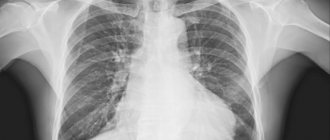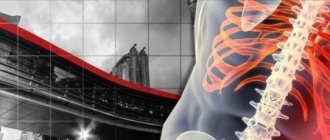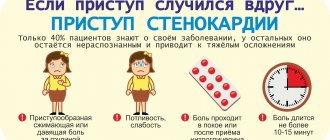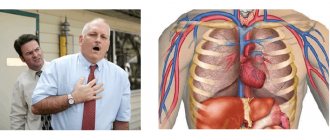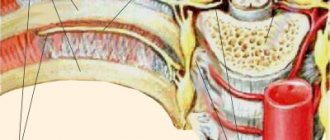Etiology
Since the thoracic spine is less mobile than the cervical spine, some experts are inclined to assume that pinching in this area rarely occurs. But that's not true. The entire length of the spinal column of a healthy person is enveloped in nerve endings that react to even the slightest disturbances in the body. The causes of chest neuralgia can be both unfavorable factors and various ailments.
Reasons for progression of pathology:
- osteochondrosis;
- herniated intervertebral discs;
- decreased body reactivity;
- inflammation in the tissues that are located next to the nerves;
- injuries of the thoracic spinal column;
- the presence of benign and malignant tumors;
- blood circulation disorder;
- hypertonicity of muscle structures;
- increased activity of the herpes virus;
- increased load on the spinal column;
- muscle spasms that occur in a person due to a sharp turn of the body;
- incorrect body position during rest;
- diseases of the cardiovascular system;
- salt deposits;
- deformation of the intercostal space;
- hormonal imbalance;
- stress;
- overwork;
- Incorrect posture can also provoke the progression of the disease, since it causes a disproportionate load on the spine.
Risk factors:
- vitamin B hypovitaminosis;
- hypothermia;
- drinking alcohol in large doses;
- vascular diseases that lead to their destruction;
- ailments associated with impaired blood circulation in nerve endings;
- metabolic disorder;
- intoxication;
- malnutrition.
Why does nerve pain occur in the chest?
Muscle strain
Since with anxiety a person is in a state of “fight and flight,” his muscles become more toned. If anxiety passes quickly, then the muscles relax safely. But if the feeling of anxiety remains for a long time, the muscles also cannot return to normal.
Such muscle strain very often leads to pain in various areas of the human body. Including in the chest.
Abdominal discomfort
Vegetative-vascular dystonia is often associated with phenomena such as bloating and increased gas production. The gases accumulated in the intestines distend the abdominal cavity, it begins to prop up the lungs and heart from below, and this leads to chest pain.
The second reason why the abdomen is a source of discomfort in the chest area is referred pain.
Excitement and nervous trepidation very often cause discomfort in the stomach. It’s not for nothing that the British call this condition “butterflies in the stomach.” So these “butterflies” very easily fly from the stomach to the chest.
Hyperventilation
This is one of the most common bodily problems that anxious neurotics encounter, because it is quite difficult to worry and not lose your breath.
The connection between hyperventilation and chest pain is as follows. Hyperventilation leads to contraction of blood vessels, and this, in turn, can cause pain, including in the chest, where the vessels are very large.
Self-hypnosis
All anxious patients with manifestations of vegetative-vascular dystonia, that is, symptoms of physical anxiety, are focused on the state of their health and pay excessive attention to it.
However, some neurotics achieve aerobatics in these actions. And they feel pain when there is none at all. And especially often they feel it in the chest, because the heart is there, and it is not healthy for them, therefore, it must hurt.
Symptoms
Intercostal neuralgia
The main symptom of neuralgia of the thoracic spine is severe pain. At the location of the pinching, a person experiences aching or burning pain. Character - paroxysmal. The pain syndrome tends to intensify when performing active movements, while sneezing or coughing, or when taking a deep breath.
Since the intercostal nerves have a lot of branches that go to vital organs, sometimes the pain can radiate to the heart, stomach, lower back, shoulder blades, etc. Gradually, the clinic is supplemented by another symptom - stiffness in the chest area. At the location of the affected nerve ending, there is a decrease or complete loss of sensitivity of the skin.
Pain syndrome is usually accompanied by the following symptoms: increased blood pressure, heart rhythm disturbances. It is worth noting that thoracic neuralgia is often confused with heart diseases due to the similarity of the clinic. Therefore, when making an accurate diagnosis, it is important to exclude pathologies of the heart muscle. To do this, you need to know the distinctive signs of neuralgia:
- attacks of pain have no connection with physical. loads. They can occur at any time, even during complete rest of the patient;
- the severity of pain directly related to chest movements;
- pain syndrome due to neuralgia can last for a long period of time, and it is not relieved by nitroglycerin;
- pain points can be felt along the spinal column, in certain areas of the chest and in the spaces between the ribs.
Treatment
To understand what to do with chest neuralgia, you should conduct a thorough diagnosis and identify the cause of the disease. The choice of therapeutic complex will depend on this. However, in the most common cases - with curvature of the spine, pinched nerves or mechanical injuries to the back - conservative methods of therapy will be the most effective.
First of all, this is therapeutic physical culture, based on kinesitherapy: dosed loads aimed at decompressing nerve roots, correcting the muscle corset and straightening posture.
Treatment methods such as massage, manual therapy, reflexology (acupuncture), and spinal traction, which is necessary to increase the intervertebral distance, are also considered no less useful. A complex of physiotherapeutic measures is considered separately, including exposure to low-frequency currents, ultrasound, laser and magnetic fields.
Medicines
Medicines for intercostal neuralgia are selected individually, depending on the cause of the pathology, but if the disease is infectious in nature, you will need to use antibacterial or antiviral drugs, as well as anti-inflammatory drugs. Consequently, in case of disorders of the endocrine system that cause intercostal neuralgia of the thoracic region, hormonal drugs will be relevant, and in case of detection of cancer, a set of appropriate measures and medications.
Painkillers for neuralgia play a significant role in the recovery process, relieving pain until the cause of the pathology is eliminated. Most often used:
- Ketanol (Ketorolac, Ketanov, Toradol);
- Ketoprofen (Flamax, Flexen);
- Ibuprofen (Nurofen, Nalgesin);
- Xefocam, Movalis, Nimesulide;
- Mydocalm, Sirdalud;
- Baralgin, Spazgan, Finalgon.
Some of the listed medications, produced in the form of ointments and creams, also have relaxing, cooling and regenerating effects. Don’t forget about vitamin complexes, in particular those containing B vitamins, thanks to which bone and muscle tissue will receive the substances necessary for recovery.
Operation
As for surgical intervention, it is used only in emergency cases and when conservative therapy is ineffective. We are talking about fractures or penetrating wounds that require repositioning of the ribs and eliminating the consequences of the injury.
In some situations, there is a need for surgery in the treatment of intervertebral hernias and oncological pathologies. For example, when a formation compressing a nerve root must be removed from the back. This type of surgery is always followed by a long recovery period with limited mobility for the patient.
Treatment at home and prevention of neuralgia
Treatment at home is an excellent addition to basic therapy. For example, exercise therapy exercises can be supplemented with warm-up or yoga classes, following medical instructions and practicing according to professionally developed methods. The training will include mainly fly-outs and amplitude swings of the arms, turns and tilts of the body, as well as breathing exercises with maximum opening of the chest.
Having identified the key symptoms, treatment of neuralgia of the thoracic spine can be carried out using hot baths with beneficial salts and essential oils added there. This will warm you up well, relax the muscles of your back and chest, and at the same time calm the excited nerve endings. In addition, experts in the field of traditional medicine recommend trying to use compresses made from steamed flaxseeds, rubbing birch buds with tincture and taking peppermint decoction orally in the morning.
In the prevention of both temporary and chronic neuralgia, prevention and basic precautions play an important role. For example, you should avoid staying in one position for a long time, especially at work or while studying, and also constantly monitor your own posture. It is equally important to exercise to comprehensively strengthen the muscular system and joints, adhere to a balanced diet and lead a healthy lifestyle.
Diagnostics
In order to accurately establish a diagnosis, one should take into account the symptoms of the disease, the duration of its course, the results of palpation examination, as well as the results of tests (instrumental and laboratory).
Laboratory techniques:
- general blood test (necessary to exclude the presence of a systemic inflammatory process in the body);
- blood biochemistry;
- taking nasopharyngeal swabs;
- blood test for the presence of infectious agents.
Instrumental techniques:
- X-ray;
- CT scan of the spine;
- MRI of the thoracic spine;
- ECG.
Therapeutic measures
Treatment of the disease is usually carried out in several stages. The first thing the doctor needs to do is eliminate the severe pain syndrome. Only after this can you begin to treat the disease that caused the pinching.
The patient is given strict bed rest for 3–4 days. The surface of the bed must be hard - this is a prerequisite for effective treatment. If necessary, you can place a hard shield under the mattress.
Drug treatment of pathology includes the following drugs:
- painkillers from the NSAID group. These drugs are included in the treatment plan to eliminate pain and relieve inflammation. If the patient experiences very severe pain, then doctors may resort to lidocaine blockade;
- muscle relaxants. These drugs help to quickly eliminate muscle spasms, thereby alleviating the patient’s condition;
- B vitamins. They must be included in the treatment plan, as they have a positive effect on nerve structures;
- sedatives.
It is also important to identify the true cause that provoked the occurrence of neuralgia. If a person has a history of any general disease, then treatment should definitely begin.
In order to restore the anatomical position of the thoracic and cervical spine, the course of treatment must include:
- massage;
- physiotherapy;
- a course of manual therapy;
- acupuncture;
- acupuncture;
- set of exercises;
- laser therapy.
If conservative treatment turns out to be ineffective, then in this case they resort to surgical treatment methods - they eliminate the root causes of the pathology (they treat osteochondrosis, herniated intervertebral discs, etc.).
Intercostal neuralgia radiates to the arm
Intercostal neuralgia is a pain syndrome that is caused by irritation of nerve endings. The mechanism of development of this disease is quite complex and consists of compression of the intercostal nerves.
Each nerve bundle contains autonomic and sensory fibers that react sharply to the slightest damage. In addition, when nerve endings are pinched, intervertebral discs become displaced, which leads to acute pain.
https://www..com/watch?v=https:accounts.google.comServiceLogin
It should be noted that intercostal neuralgia is not considered a separate disease. The background for its development is concomitant diseases or negative changes occurring in the body.
Therefore, before treatment, it is necessary to determine the underlying pathology, since pinching of the intercostal nerves is often one of the signs of a serious pathology.


